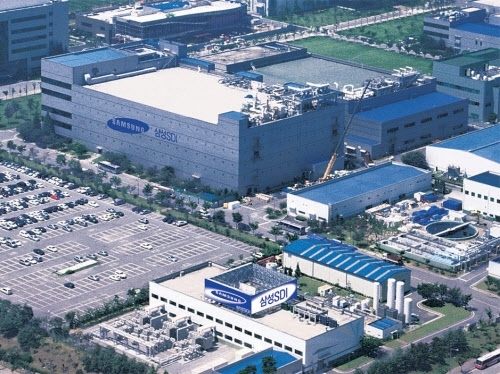Samsung SDI to reinforce safety for defective battery cells
이 글자크기로 변경됩니다.
(예시) 가장 빠른 뉴스가 있고 다양한 정보, 쌍방향 소통이 숨쉬는 다음뉴스를 만나보세요. 다음뉴스는 국내외 주요이슈와 실시간 속보, 문화생활 및 다양한 분야의 뉴스를 입체적으로 전달하고 있습니다.

Samsung SDI is charting a hard course to ward off battery defects, holding a symbolic ceremony to put an end to faulty small lithium-ion batteries.
According to a source familiar with the matter, the South Korean battery producer will hold an internal ceremony this week at its facility in Cheonan, South Chungcheong Province, under the resolute will of CEO Jun Young-hyun to eradicate any lax attitude toward potential fire hazards stemming from faulty batteries. Included will be a kind of vow by representatives to reinforce safety and quality as they discard defective batteries by submerging them in saline water, a typical way of completely discharging lithium-ion cells.
“CEO Jun has ordered the discarding ceremony of defective small batteries in a bid to hike a sense of vigilance throughout the company,” the source told The Korea Herald.
This comes amid safety woes over Korean-made battery cells after a series of fires thought to have been caused by defective battery cells. In one of the latest events, a fire broke out in November at Samsung SDI’s storage warehouse in Seremban, Malaysia, where it had faulty batteries undergoing the saline solution process.
“The CEO has highlighted quality as the top priority this year amid the company’s growing presence in the battery industry,” the official said. “This is an internal event for employees to take part in the existing process of defective products’ disposal, with the purpose of the event being to strengthen the company’s New Year’s resolution to prioritize quality above anything else.”
The ceremony will be held online, considering the current COVID-19 pandemic situation, with a few representatives from the quality management department in attendance, the company’s senior official explained.
A ceremony of publicly disposing faulty products at Samsung dates back to 1995. Then-Samsung Chairman Lee Kun-hee had ordered the mass burning of the company’s Anycall cellphones worth about 50 billion won ($45.7 million) in front of some 2,000 Samsung Electronics employees, determined to bring up the quality of their products.
Lithium-ion batteries are rechargeable power units whose mechanism is enabled by the continuous move of electrons between the cathode and the anode, which are divided by a separator that is permeable for electrolytes.
When electrons are in the cathode domain, the battery is charged, and when they have completely moved over to the anode area, riding the electrolytes, the battery is dead and requires recharging.
As electricity is fed to the battery, the electrons once again move over to the cathode domain and the cycle repeats.
The catch is that when the separator between the cathode and the anode fails -- allowing the two sides to meet -- the battery combusts. The safety of the battery relies heavily on the separator technology and zero impurities in the battery.
And although every battery maker strives for the most stable product output, every factory from each company has a confidential figure for the number of defective products coming out of their facilities in a year.
These defective products are soaked in saline solution for the full discharge of their electrons for safety, and then recycled to minimize loss.
Even so, the faulty batteries can lead to fire accidents.
With large lithium-ion batteries, Samsung SDI was tagged with combustion woes in 2020, with its client automaker BMW recalling plugged-in hybrid vehicles from the BMW X1 to X5, Mini Countryman and BMW i8.
BMW reportedly said that it is highly likely that either of its two suppliers -- China’s CATL or Korea’s Samsung SDI -- had battery cells that were the cause of the vehicles catching fire.
The US National Highway Traffic Safety Administration investigated four cases of “thermal events” from BMW plug-in hybrid electric vehicles reported between August and September last year.
“A review of supplier production and process change records indicated that for the incident vehicles, battery cell production at the supplier occurred during a specific and limited time period. Further reviews indicated that during this time period, a higher rate of impurities could have been allowed to enter one or more battery cells,’ said the NHTSA, when it ordered the recall of seven models of BMW plugged-in hybrids on the road, amounting to almost 4,500 units.
At its 2020 year-end personnel reshuffle, Samsung SDI replaced the head of the large battery business in charge of electric vehicle battery management.
The quest to bring up the quality and safety of batteries is an industrywide endeavor. Another Korean battery maker, LG Chem had also been troubled by Hyundai Motor’s Kona EV bursting into flames.
“Samsung SDI’s renewed stance to pull up its safety standards appears to be in favor of the worldwide attention on eco-friendly energy and EVs in 2021,” an industry insider said.
By Lim Jeong-yeo and Kim Byung-wook (kaylalim@heraldcorp.com), (kbw@heraldcorp.com)
<ⓒKoreaHerald(www.koreaherald.com)무단전재 및 재배포 금지>
Copyright © 코리아헤럴드. 무단전재 및 재배포 금지.